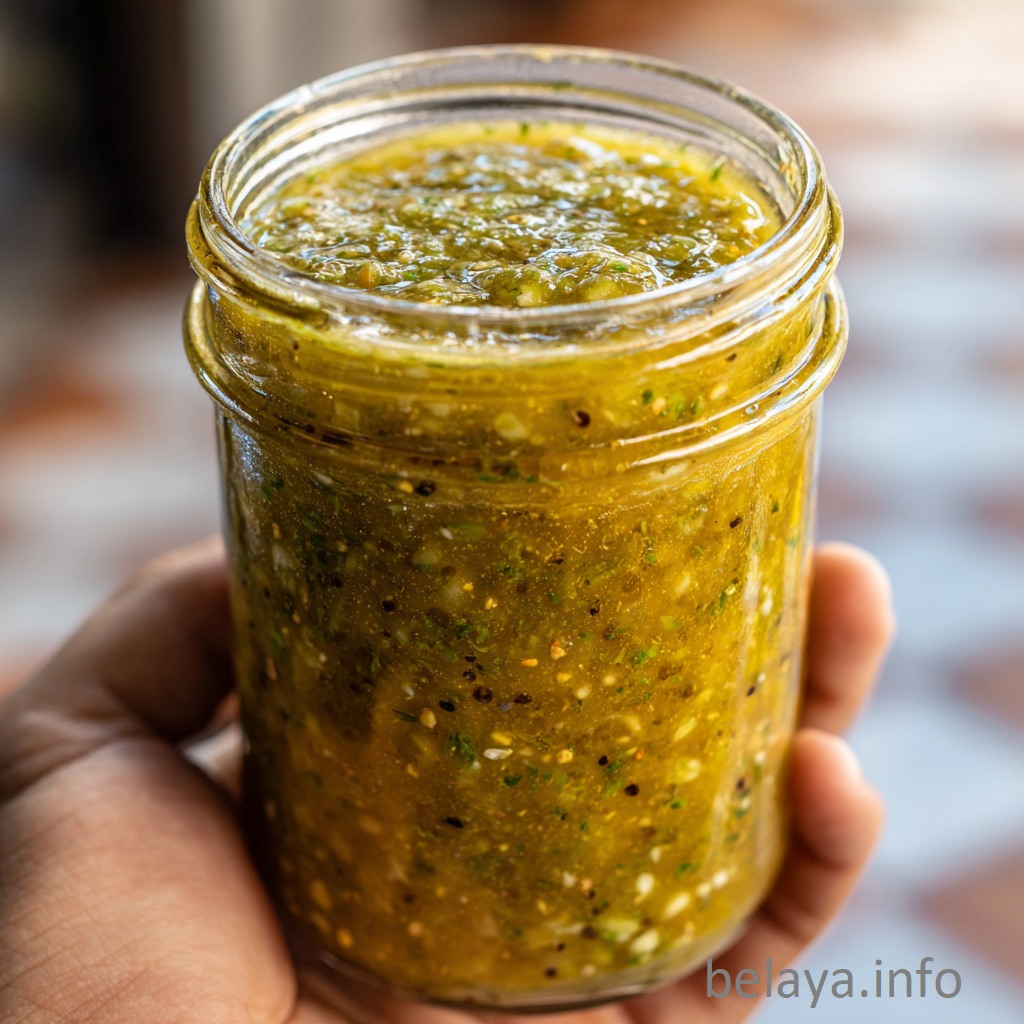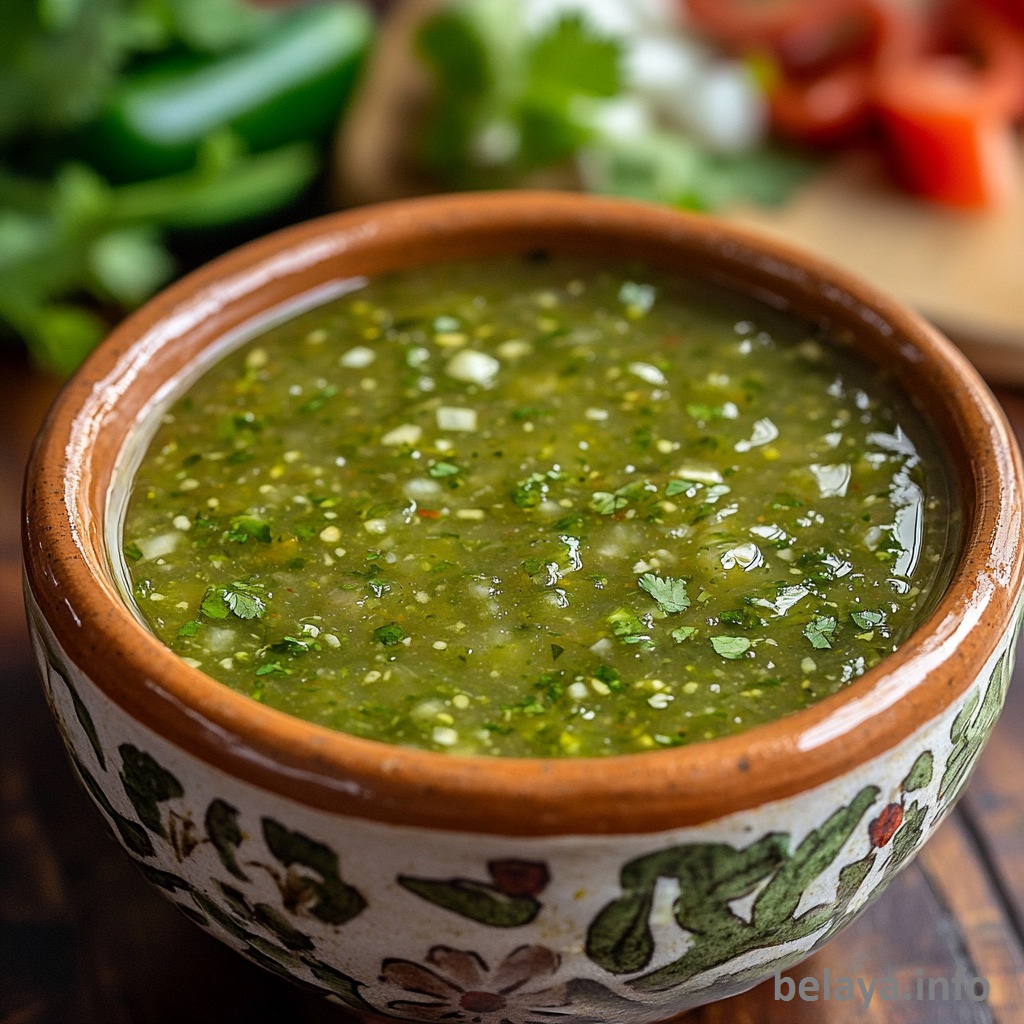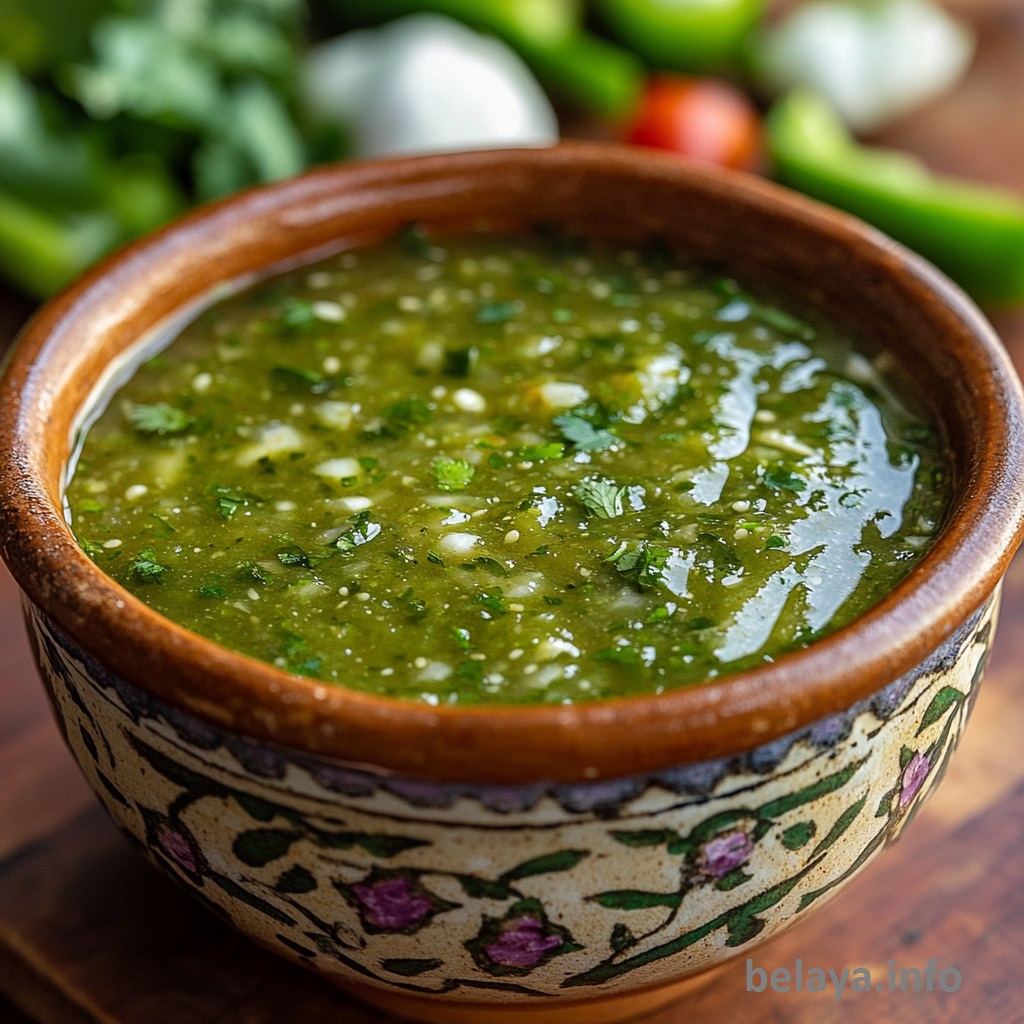Homemade Salsa Verde
Bright, zesty, and full of character, this Homemade Salsa Verde captures the soul of traditional Mexican flavor with every spoonful. Built on the smoky tang of roasted tomatillos and the vibrant heat of jalapeños, it’s both refreshing and bold.
The fresh cilantro and lime juice cut through the richness, creating a balance of acidity and herbal brightness. Whether served as a dip, a topping, or a marinade, this versatile green salsa is a kitchen essential—simple to prepare, yet endlessly customizable.
Add avocado for a creamy twist, and you’ve got a silky, velvety sauce that brings depth and authenticity to any meal.

Why People Will Love This Homemade Salsa Verde Recipe:
Authentic Flavor from Simple Ingredients: The combination of roasted tomatillos, jalapeños, lime juice, and cilantro captures the vibrant, smoky, and tangy flavor profile that defines true Mexican salsa verde.
Customizable Heat and Texture: With flexible options for spice level and an optional creamy avocado version, it caters to a wide range of palates—from mild and refreshing to bold and fiery.
Nutrient-Rich and Naturally Fresh: Made from whole, fresh ingredients with no preservatives, this salsa is both health-conscious and packed with immune-boosting nutrients like vitamin C, antioxidants, and fiber.
Versatility in the Kitchen: This salsa isn’t just a dip—it’s a multipurpose condiment that elevates tacos, grilled meats, eggs, burrito bowls, roasted vegetables, and more with one spoonful.
Quick and Easy Preparation: Despite its layered flavors, the recipe comes together quickly with minimal prep and cleanup, especially using a broiler and blender. It’s ideal for both weekday cooking and special gatherings.
Make-Ahead Friendly: The flavor improves as it chills, making it perfect for meal prep or entertaining. It thickens naturally in the fridge, allowing it to be used as a dip, sauce, or dressing with ease.
Naturally Gluten-Free, Vegan, and Dairy-Free: The base recipe fits many dietary lifestyles without modification, making it an inclusive crowd-pleaser for parties, potlucks, or family meals.
Key Ingredients:
Tomatillos: The foundation of this salsa, tomatillos bring a tart, citrusy brightness and natural pectin that gives the salsa body. When roasted, their flavor deepens into a smoky, slightly caramelized tang that defines the salsa’s essence.
Jalapeños: These versatile peppers offer both flavor and heat. Roasting them mellows their bite while intensifying their earthy, green notes. Adjusting the number of jalapeños allows for perfect control over spiciness.
White Onion: Raw yet balanced by the other ingredients, white onion contributes sharpness and aromatic depth, helping bridge the acidity of the tomatillos with the freshness of the cilantro.
Fresh Cilantro: Herbal, citrusy, and slightly peppery, cilantro provides the green freshness that brightens the entire salsa. It brings a signature vibrancy that cuts through the richness of roasted ingredients.
Lime Juice: Fresh lime juice elevates the salsa with its acidity, adding balance and zing. It accentuates the flavors of the tomatillos and brings a clean, crisp finish.
Salt: Essential for unlocking the complexity of every other ingredient, salt brings balance and ensures the natural sweetness, tang, and spice are harmonized.
Optional Avocado: When added, avocado transforms the salsa into a rich, creamy version. Its healthy fats provide smoothness and weight, turning the salsa into a dip or spread that feels indulgent yet fresh.
Expert Tips:
Roast for Flavor Depth: Always roast tomatillos and jalapeños until they develop blackened, blistered spots. This caramelization adds smoky depth and mellows the tomatillos’ sharp acidity, transforming them into a rich flavor base.
Use the Juices: When transferring roasted vegetables to the blender, don’t discard the juices left on the pan. They carry concentrated flavor from the roasted ingredients and should be blended in to amplify taste and texture.
Adjust Acidity Last: Lime juice should be added gradually and tasted after blending. Acidity intensifies as the salsa sits, so it’s best to slightly under-acidify at first, then adjust after chilling if needed.
Cool Before Adding Avocado: If making the creamy variation, let the salsa cool completely before blending in avocado. Adding avocado to hot salsa can cause discoloration and a slightly bitter aftertaste.
Blending Technique Matters: For a more rustic salsa, pulse briefly to leave a chunkier texture. For a smooth version, blend longer—but pause and scrape down the sides to ensure even consistency.
Let It Rest for Full Flavor: While the salsa can be eaten right away, chilling it for at least 1–2 hours allows the flavors to meld and deepen. The natural pectin in tomatillos will also thicken the salsa, improving texture.
Layer the Heat: For complexity, consider using both roasted and raw jalapeños. A roasted one adds smokiness, while a sliver of raw pepper can bring bright, fresh heat. Taste and balance accordingly.

Homemade Salsa Verde
Ingredients:
1 ½ pounds tomatillos (about 12 medium), husked and rinsed
1 to 2 medium jalapeños, stemmed (omit for mild salsa, use 1 jalapeño for medium salsa and 2 jalapeños for hot salsa, note that spiciness will depend on heat of actual peppers used)
½ cup chopped white onion (about ½ medium onion)
¼ cup packed fresh cilantro leaves (more if you love cilantro)
2 tablespoons to ¼ cup lime juice (1 to 2 medium limes, juiced), to taste
½ to 1 teaspoon salt, to taste
Optional variation: 1 to 2 diced avocados, for creamy avocado salsa verde
Instructions:
Prep the Broiler:
Set your oven’s broiler to high and position an oven rack about 4 inches beneath the heating element.
Roast the Tomatillos and Jalapeños:
Arrange the tomatillos and jalapeños on a rimmed baking sheet. Broil for about 5 minutes, or until charred in spots.
Use tongs to flip them over and continue broiling for another 4–6 minutes, until nicely blistered and blackened in patches.
Blend the Base:
While the vegetables roast, add chopped onion, cilantro, lime juice (start with 2 tablespoons), and ½ teaspoon of salt into a blender or food processor.
Add the Roasted Ingredients:
Carefully transfer the hot tomatillos and jalapeños along with their juices into the blender. Blend until the texture is mostly smooth, scraping down the sides if needed.
Adjust Seasoning:
Taste the salsa and add more lime juice or salt as needed for balance.
Chill and Thicken:
Let the salsa rest in the fridge for a few hours—it will naturally thicken as it cools due to the tomatillos’ pectin.
Optional – Make It Creamy:
For a creamy variation, allow the salsa to cool completely, then blend in 1 to 2 diced avocados until smooth and silky.

Important Notes When Making Homemade Salsa Verde:
Tomatillo Quality Affects Everything: Choose firm, bright green tomatillos with tight husks. Overripe or underripe tomatillos can alter the salsa’s balance—too soft may result in a watery texture; too underripe will bring excessive sourness.
Roasting Isn’t Optional—It’s Foundational: Raw tomatillos are extremely acidic and sharp. Roasting mellows their bite, develops umami, and creates the signature smoky-sweet complexity that defines an authentic salsa verde.
Heat Level Varies Wildly by Pepper: Jalapeños can range from mild to surprisingly hot, even among peppers of the same batch. Taste a small slice before using, and adjust the number accordingly to avoid overpowering heat.
Salsa Will Thicken Over Time: Thanks to the natural pectin in tomatillos, the salsa will firm up significantly after chilling. Keep this in mind when judging thickness right after blending—it may seem thin initially but will settle into a perfect consistency.
Blender vs. Food Processor: A high-speed blender will yield a smoother, more emulsified salsa, ideal for drizzling or creamy versions. A food processor results in a chunkier texture, which works well as a topping or dip.
Lime and Salt Are Key to Balance: These two ingredients act as final adjusters. Lime lifts the flavor, and salt ties everything together. Undersalting or under-acidifying will leave the salsa flat—adjust cautiously but confidently after blending.
Don’t Add Avocado Too Soon: Avocados are sensitive to heat and air exposure. If added while the salsa is hot, they can turn bitter or grayish. Blend them in only once the salsa is fully cooled, and store in an airtight container to avoid browning.

How To Enjoy Homemade Salsa Verde After Cooking:
Let It Chill for Best Flavor
After blending, allow the salsa to rest in the refrigerator for at least 1–2 hours. This rest period helps the flavors meld and deepens the overall complexity. The natural pectin in the tomatillos will also thicken the salsa, giving it a better consistency for dipping or drizzling.
Stir Before Serving
Before serving, give the salsa a good stir. This ensures any settled juices are re-incorporated and the texture is even throughout. If it has thickened too much, a splash of water or lime juice will refresh the consistency.
Enjoy It Multiple Ways
Homemade Salsa Verde is incredibly versatile. Use it in any of the following ways:
As a dip: Serve with tortilla chips for a bold, tangy snack or appetizer.
As a topping: Drizzle over tacos, grilled meats, nachos, or eggs.
As a dressing: Thin with a bit of olive oil or water and toss with roasted vegetables or grain bowls.
As a sauce: Spoon over enchiladas, burritos, or use as a marinade for chicken or fish.
Serve in Small Batches
If serving at a gathering or over time, keep the main batch chilled and only portion out what’s needed. This helps preserve freshness, especially if you’ve added avocado, which can oxidize faster when exposed to air.
Pair with Complementary Dishes
Salsa verde pairs beautifully with:
Carnitas or grilled chicken
Chilaquiles or huevos rancheros
Black bean tacos or veggie fajitas
Quesadillas or taquitos
Its acidity and brightness cut through rich, savory flavors, enhancing the dish without overpowering it.
Store and Use Leftovers Creatively
Refrigerate in an airtight container for up to 5–7 days (or 2–3 days with avocado). Leftovers can be used to:
Liven up leftovers like rice or roasted vegetables
Swirl into soups or stews for brightness
Mix into mayo or yogurt for a zesty sandwich spread

Nutrition Information:
Per 2-tablespoon serving of Homemade Salsa Verde (without avocado), in your requested format:
Calories: 20 kcal | Total Fat: 0.6 g | Saturated Fat: 0.1 g | Monounsaturated Fat: 0.3 g | Polyunsaturated Fat: 0.1 g | Cholesterol: 0 mg | Sodium: 90–140 mg (depending on added salt) | Total Carbohydrates: 4.0 g | Dietary Fiber: 1.3 g | Sugars: 2.1 g | Protein: 0.6 g
Optional Variation with 1 Medium Avocado (Creamy Avocado Salsa Verde)
Per 2-tablespoon serving:
Calories: 35 kcal | Total Fat: 2.3 g | Saturated Fat: 0.3 g | Monounsaturated Fat: 1.3 g | Polyunsaturated Fat: 0.4 g | Cholesterol: 0 mg | Sodium: 100–150 mg (depending on added salt) | Total Carbohydrates: 3.5 g | Dietary Fiber: 1.3 g | Sugars: 1.7 g | Protein: 0.7 g

Frequently Asked Questions:
Frequently Asked Questions (FAQs) with thoughtful, helpful answers for the Homemade Salsa Verde recipe:
Can I use raw tomatillos instead of roasting them?
Yes, but roasting is highly recommended. Raw tomatillos are very tart and sharp, while roasting softens their acidity and adds a subtle smokiness that gives the salsa a much more complex, balanced flavor.
How spicy will this salsa be with 1 or 2 jalapeños?
The heat level varies depending on the actual peppers used. One jalapeño typically yields a medium heat, while two can make it fairly hot. Always taste your jalapeños before using, and start with one if unsure—you can always add more heat, but not remove it.
How long does homemade salsa verde last in the fridge?
Stored in an airtight container, it will last up to 5 to 7 days in the refrigerator. The flavor often improves after the first day. If you’ve added avocado, consume it within 2 to 3 days for the best texture and color.
Can I freeze this salsa verde?
Yes, the non-avocado version freezes very well. Pour into freezer-safe containers or bags, leaving room for expansion. Thaw in the refrigerator before use. Avoid freezing the avocado version, as the texture can become watery or grainy when thawed.
What dishes pair well with salsa verde?
Salsa verde is incredibly versatile. It’s perfect with tacos, grilled chicken, enchiladas, eggs (like chilaquiles or huevos rancheros), roasted vegetables, and as a zesty topping for rice bowls or nachos.
What’s the best way to roast tomatillos and jalapeños for maximum flavor?
Use a broiler, cast iron skillet, or grill to roast them until blistered and blackened in spots. This caramelization deepens flavor and balances the tomatillos’ natural acidity. Don’t skip this step—it’s essential for authentic taste.
Should I peel the tomatillos after roasting?
No need to peel roasted tomatillos. Their skins become soft and flavorful when blistered. Just transfer them and their juices straight into the blender to retain their full flavor and natural thickening power.
Can I blend everything at once, including the hot roasted ingredients?
Yes, you can—but use caution. If using a blender, make sure to vent the lid slightly or remove the small center cap and cover with a kitchen towel to prevent steam buildup, which can cause pressure and splatter.
Why is my salsa too watery or too thick?
If too watery, it may be due to excess liquid from overripe tomatillos or not enough blending time. Let it chill—the natural pectin in tomatillos will thicken the salsa in the fridge. If it’s too thick, add a splash of water or lime juice to loosen it.
When should I add the avocado for creamy salsa verde?
Wait until the salsa is completely cool before blending in avocado. Adding it to hot salsa can result in a bitter flavor and dull, gray color. Use ripe avocados for the best creamy texture and fresh flavor.